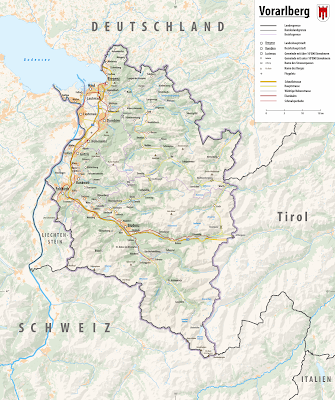Then I came across a lecture by Professor Alois Niederstätter on the topic "Why the Vorarlbergers wanted to become Swiss in 1919 – and why the canton of 'Übrig' never came to be."

|
| Click to enlarge (©Tschubby/Wikipedia) |
Vorarlberg has a 321 km long border, 110 km of which is shared with the German state of Bavaria, 142 km with the Swiss cantons of St. Gallen, Graubünden, and the Principality of Liechtenstein, but only 69 km with the Austrian state of Tyrol.
In contrast, Austria's western province is open to the west and north, i.e., easily accessible from Switzerland, Liechtenstein, and Germany. A trip from Bregenz to Vienna by train took eight hours at that time.
So it was only natural that after the Danube Monarchy was reduced to a German remnant of Austria after World War I, there were efforts in Vorarlberg to join the Swiss Confederation.
It also made sense linguistically, because unlike the rest of Austria, the people of Vorarlberg do not speak Bavarian dialects, but Alemannic dialects, which are related to those spoken in German-speaking Switzerland, southern Baden, and Alsace.

|
| The Austro-Hungarian Emperor Karl in uniform and Empress Zitta, née Bourbon-Parma, visited Vorarlberg in 1917. |
An "Advertising Committee" met with great interest among the Vorarlberg parties and endeavored to push ahead with the political implementation of the Anschluss (annexation).

|
| "Advertising" even in the French-speaking part of Switzerland (©Wikipedia) |
|
Hör uns Helvetia
Schirm uns Helvetia,
Führ' unser Heimatland
Lodert ihr Feuer heut ' |
Hear us, Helvetia
Protect us, Helvetia,
Lead our homeland
Let your fires blaze today |
After the end of the war, things moved quickly. On February 28, 1919, Vorarlberg introduced universal suffrage for men and women, and by March, the first state constitution had been drafted and the first state elections were held on April 27, 1919. The conservative-federalist Christian Social Party, which at that time was also secessionist in Vorarlberg, won over 63% of the votes and 22 of the 30 seats in the state parliament.
With foresight, the people of Vorarlberg had modeled their constitution on the Swiss cantonal constitutions with their direct democracy. This was a signal, "We are open to Switzerland. The Swiss are our Alemannic relatives. In contrast, Vienna is ruled by a Jewish state, from which we want to separate under all circumstances."
This set alarm bells ringing in Vienna. There was already talk of Switzerland's 23rd canton.

|
| Der Landeshauptmann Vorderösterreichs Dr. Otto Ender |
*There were also separatist movements in Tyrol. There, 90% of the population voted in favor of joining the German Reich.
Meanwhile, the Swiss Federal Council discussed the significance of Vorarlberg's annexation. They did not want to upset the carefully balanced relationship between languages and religions in Switzerland by adding another canton with German-speaking Catholics. Hadn't Vorarlberg been bled dry by the war? Vorarlberg may be better off as an independent state. As a result, the desire for annexation among the people of Vorarlberg did not gain majority support in Switzerland. Soon, the word "Kanton Übrig" (Superfluous Canton) began to circulate.
The Schwabenkapitel, an influential group in Vorarlberg, advocating den Anschluss an Schwaben (annexation to Swabia), i.e., Germany, had used the term "Kanton Übrig" for the first time in a polemical pamphlet.
The Treaty of Saint-Germain imposed significant losses of German-speaking territories: The area in black was claimed by Austria. Red is the final state border fixed in the Treaty. N.B. South Tyrol and the region around Trieste were lost to Italy, and the Sudetenland to the Czech Republic.
After World War II in 1945, the same scenario arose like a specter: Switzerland as a role model for the people of Vorarlberg.
This time, Vienna hastily arranged for Vorarlberg's Anschluss to the eastern part of Austria through railway and road tunnels. Motorists no longer have to struggle along narrow mountain passes, and the journey by train between Bregenz and Vienna now takes only 6 1/2 hours.

No comments:
Post a Comment